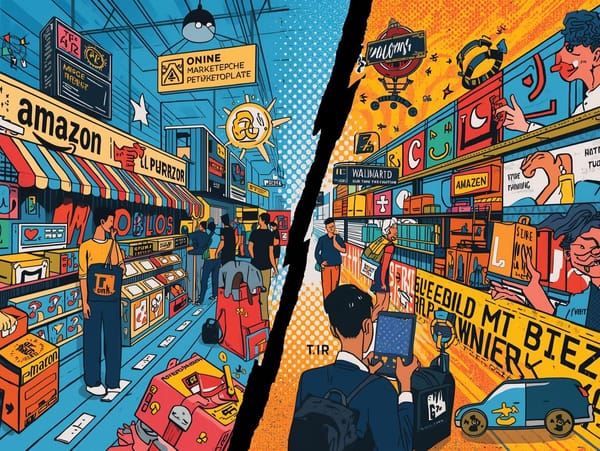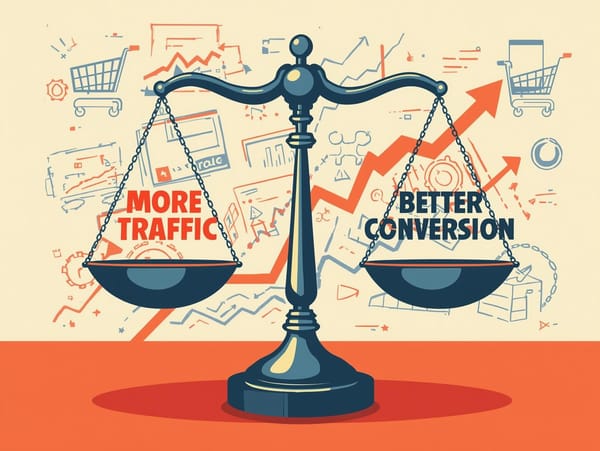How Ecom Sellers Are Actually Using Generative AI (GenAI) To Grow Revenue, Not Just Write Copy

Direct-to-consumer brands are being pitched GenAI tools from every direction: AI copy, AI creative, AI chat, AI analytics. It’s noisy enough that many founders are asking a simple question:
“Where is GenAI actually driving revenue for ecommerce brands—and what should I do first?”
This post breaks down how ecommerce sellers are using GenAI today across the customer journey, with a bias toward measurable impact for DTC brand owners:
- Where GenAI is delivering real lift (with current industry examples and trends)
- How to prioritize use cases by ROI and implementation effort
- What to watch out for: data quality, over-personalization, and workflow chaos
- A practical rollout plan for a lean DTC team
1. Why GenAI Matters for DTC Right Now
Recent industry coverage paints a clear picture:
- AI is now table stakes in ecommerce. TechRepublic calls AI “the engine powering personalized experiences, dynamic pricing, and data-driven growth for merchants big and small,” emphasizing that AI in ecommerce is moving from “nice-to-have” to infrastructure.
- Boards and leadership teams are all-in on GenAI. CMSWire reports that GenAI is now on the boardroom agenda for 95% of organizations, with over half of executives saying their leadership teams have concrete GenAI plans. That pressure trickles down to growth and ecommerce teams.
- Retailers are using AI heavily for peak moments. Sourcing Journal highlights how brands are using AI to optimize holiday planning—assortment, pricing, promos, and campaign timing—to capture demand spikes more efficiently.
For DTC brands, this means two things:
- Your competitors are already experimenting. Even scrappy teams are adopting GenAI tools embedded in email platforms, ad managers, and helpdesks.
- The edge isn’t “using AI” but where and how you use it. Competitive advantage comes from plugging GenAI into the right points of your funnel and data stack—not just asking ChatGPT for ideas.
2. High-Impact GenAI Use Cases Across the DTC Funnel
Let’s walk the customer journey and focus on concrete, revenue-linked uses of GenAI that smart ecom sellers are implementing.
2.1 Acquisition: Ads, Creatives, and Top-of-Funnel Content
What’s happening in the market
- Articles from CMSWire and Inc. point to GenAI being used widely in creative testing and personalization—from generating multiple ad variants to tailoring messaging to micro-segments.
- Retail case studies show brands using AI to create and iterate creatives faster ahead of major retail periods (e.g., Black Friday, holiday) so they can test more ideas with the same budget.
Tactical use cases for DTC founders
- Rapid Ad Creative Generation & Testing
- Generate multiple headline + hook + value prop combinations for Meta/TikTok/Google.
- Use GenAI to create variations per:
- Audience (e.g., “new moms vs. fitness enthusiasts”)
- Use case (gifting, self-care, performance, sustainability)
- Then feed performance data back into your prompts or tools:
- “Generate new variants similar to these top 3 winners; reduce emphasis on discounts, emphasize social proof.”
- Search & Shopping Feed Optimization
- Use GenAI to re-write product titles and descriptions in bulk to:
- Include high-intent keywords
- Clarify benefits and use-cases
- Conform to marketplace rules (Google Shopping, Amazon, etc.)
- Top-of-Funnel Content at Scale
- Generate SEO content outlines, blog drafts, and educational content to support non-brand search and affiliate/partner strategies.
- Keep humans in the loop to ensure:
- Brand voice alignment
- Accuracy and compliance
- Deep product knowledge
What to measure
- CTR and CPC changes per creative cohort
- Cost per add-to-cart / cost per checkout started
- Volume of ad variations tested per week/month vs. pre-GenAI
2.2 On-Site Experience: Personalization, CRO, and Merchandising
What we’re seeing in the market
- Inc. notes that AI-driven personalization is exploding—but also warns about “too much” personalization that feels creepy or chaotic.
- CMSWire stresses that data quality and infrastructure are prerequisites. Many CX leaders are investing in clean customer and product data before turning up personalization.
Practical GenAI use cases on your site
- Dynamic Product Messaging by Segment
- Use GenAI to generate micro-copy variants based on:
- Traffic source (paid social vs. search vs. email)
- Device (mobile vs. desktop)
- Lifecycle (new visitor vs. returning vs. VIP)
- Example:
- New visitors: “Over 50,000 customers trust us to…”
- Returning browsers: “Welcome back—these picks are based on what you loved last time.”
- AI-Assisted Product Detail Pages (PDPs)
- Draft benefit-driven descriptions for each product and auto-generate:
- Feature bullets
- Use-case scenarios
- “Compare to” sections
- Use GenAI to spin PDP variants for A/B testing:
- Version A: social proof + urgency
- Version B: education + detailed ingredients/materials
- Intelligent Bundling & Cross-Sell Copy
- Pair your existing frequent-bought-together logic with GenAI-powered copy:
- “Complete the look with…”
- “Most customers who bought X also picked Y for [specific use case].”
- Use past order data to train patterns (even via simple prompt engineering) about why products go together.
What to measure
- PDP conversion rate uplift vs. control
- Average order value (AOV) from bundles / cross-sells influenced by AI-generated copy
- Scroll depth and on-page engagement with new PDP formats
2.3 Retention: Email, SMS, and Lifecycle Journeys
Macro trend
- Across ecommerce, GenAI is quickly becoming standard within ESP and CRM platforms, helping marketers personalize subject lines, body copy, and SMS at scale.
- Articles on AI in marketing highlight that brands want faster iteration and optimization, not just more content.
High-ROI lifecycle use cases
- Browse/Cart Abandonment Flows
- Use GenAI to produce tiered flows:
- Email 1: helpful reminder + UGC
- Email 2: educational content (how to use, care tips, sizing guidance)
- Email 3: tailored incentive for fence-sitters (if profitable)
- Personalize by product category:
- Skincare: focus on ingredients and regimen
- Apparel: fit, styling ideas, shipping/returns reassurance
- Post-Purchase Education & Upsell Sequences
- Generate post-purchase flows that:
- Help customers succeed with the product (how-to, FAQs, tips)
- Introduce complementary items in a helpful, contextual way
- Use customer attributes (first-time vs. repeat, product type, AOV) to tweak tone and offer intensity.
- Win-Back and Reactivation
- Train prompts with your brand story, reviews, and most compelling benefits, then:
- Generate different win-back angles: “new product drop,” “refreshed formula,” “you might have missed…”
- Test positive framing (“we’ve been improving things for you”) against discount-led messaging.
What to measure
- Revenue per recipient (RPR) by flow
- Flow-triggered revenue share vs. campaigns
- Churn rate / time-to-repeat purchase
2.4 Customer Support & Feedback Loops
What’s happening in the market
- Retailers are increasingly blending GenAI-powered assistants with human agents—especially around holidays—so they can scale support without exploding headcount.
- The same content generated for marketing (FAQs, how-to, policy explanations) is reused in support contexts.
Practical applications for DTC
- AI-Powered Help Centers & Chat
- Use GenAI to:
- Generate and maintain FAQs from your knowledge base.
- Draft polite, on-brand replies to common questions (shipping, returns, sizing, ingredients).
- Human agents review or edit AI-suggested responses for edge cases.
- Turning Support Transcripts into Insights
- Feed chat/email transcripts (anonymized) into GenAI summarizers:
- Extract top 10 complaints per month
- Identify patterns by product, region, or channel
- Use outputs to:
- Inform site messaging (clarify confusing points ahead of time)
- Adjust PDP content, size guides, policies
What to measure
- First response time and resolution time
- CSAT / NPS changes
- Reduction in ticket volume per order over time
3. Under the Hood: Data and Infrastructure DTC Brands Need
A recurring warning from CX and martech leaders: “Before AI personalization, fix the data.”
CMSWire reports that while executives are bullish on GenAI, many are hitting walls because of fragmented customer data and messy product catalogs. For DTC, this means:
- Clean, Consistent Product Data
- Standardized attributes: size, color, material, use case, benefits, price, stock.
- Clear taxonomy so GenAI can reason about relationships:
- “This product is best for summer outdoor use / curly hair / sensitive skin.”
- Basic Customer Data and Events
- Source-of-truth events: viewed product, added to cart, purchased, unsubscribed.
- Simple segmentation: new vs. repeat, high LTV vs. low, category preferences.
- A Single “Home” for Content
- Central repository (Notion, GDrive, CMS) for:
- Brand voice guidelines
- Product education
- FAQs and policy docs
- This becomes the context pack you repeatedly feed into GenAI tools so outputs are on-brand and accurate.
Without this foundation, you risk:
- Off-brand, generic AI copy
- Bad recommendations (e.g., suggesting out-of-stock items)
- Over-personalization that feels random, not helpful
4. A Practical Rollout Plan for Lean DTC Teams
If you’re a DTC founder or head of growth, you don’t need a “GenAI transformation program.” You need a 90-day, revenue-focused plan.
Phase 1 (Weeks 1–3): Quick Wins and Guardrails
- Choose 1–2 tools embedded where you already work:
- ESP/CRM (Klaviyo, Omnisend, etc.)
- Ad platforms’ native AI features
- Your helpdesk (Gorgias, Zendesk, etc.)
- Define brand voice rules and “do not do” examples.
- Launch:
- AI-assisted ad variations for 1–2 campaigns
- AI-assisted copy for cart abandonment + one post-purchase flow
- Set baselines: key metrics from the last 30–60 days.
Phase 2 (Weeks 4–8): Expand to Site and Analytics
- Use GenAI to:
- Improve and test PDP messaging (benefits, FAQs, social proof).
- Draft A/B test variants for landing pages and key funnels.
- Layer analytics:
- Weekly review of test performance: winners, losers, new hypotheses.
- Start using GenAI as an analytics assistant:
- “Summarize performance differences between AI-generated creatives vs. manual creatives in the last 30 days.”
Phase 3 (Weeks 9–12): Close the Loop and Systematize
- Build a simple feedback loop:
- What AI-generated assets worked best?
- What patterns can you encode into prompts or templates?
- Start documenting:
- “Winning prompts” for your brand.
- Playbooks for using GenAI in ad launches, PDP updates, and lifecycle tweaks.
- Evaluate new use cases only after existing ones are stable:
- AI-powered onsite assistants
- More advanced personalization
5. Common Pitfalls DTC Brand Owners Should Avoid
- Letting AI define your brand
- Your distinctiveness is your moat. GenAI should amplify voice, not replace it.
- Personalizing before you’re accurate
- If your data is messy, more personalization just means more irrelevance.
- Measuring output, not outcomes
- “We created 200 emails” is meaningless. Track revenue, margins, LTV, and support costs.
- Siloed experimentation
- Growth runs AI tests in ads while CX and support don’t know about them. Make sure learnings are shared.
6. Action Checklist for DTC Brand Owners
If you do nothing else, in the next 30 days:
- Pick 2 use cases:
- Ad creative variation and testing
- Cart abandonment + post-purchase flows
- Document your brand voice in a 1–2 page “AI brief.”
- Clean up product data for your top 20% SKUs by revenue.
- Set clear metrics:
- Target lift in CTR, conversion rate, RPR, or AOV.
- Review weekly:
- What did GenAI help ship that you wouldn’t have done otherwise?
- Which experiments drove measurable revenue?
GenAI isn’t a silver bullet, but for DTC ecommerce, it’s becoming a force multiplier—helping lean teams create, test, and learn faster across acquisition, onsite experience, and retention.



